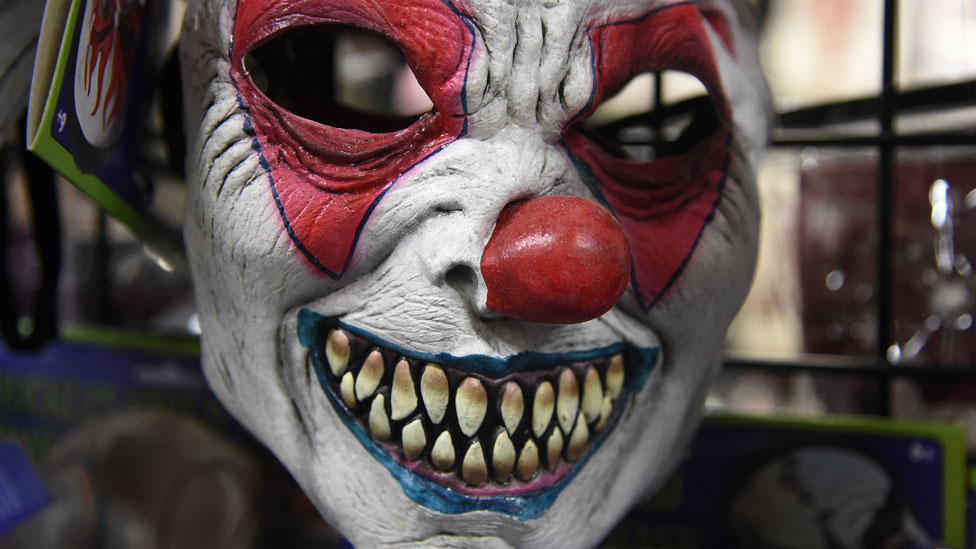
 Image copyright AFP/Getty Images
Image copyright AFP/Getty Images Canadian schools are wrestling with how to guide students and parents towards Halloween costumes that aren’t considered offensive or culturally insensitive.
In early October, a Canadian school board emailed a checklist “Is my costume appropriate?” to parents planning their children’s Halloween costumes.
Fuschia Martians, mythical creatures, and animals got the all clear.
On the what not to wear list for 31 October – cowboy and Indian costumes, slaves, terrorist, gypsy, Rastafarian and “urban ghetto resident”.
The checklist from the Conseil scolaire Viamonde, which oversees 51 schools in Ontario, was criticised as an example of political correctness gone haywire.
But school board spokeswoman Claire Francoeur said the guidelines, first sent out in 2016, has generally garnered positive reactions from parents.
She says complaints mostly stemmed from stressed parents frustrated at “having another thing to think about” or who had hoped to recycle old costumes that failed the checklist.
The board believes strongly in its values of “respect for each other” and that includes Halloween, Francoeur says.
“We live in a society that has changed a lot in the past 10, 15 years,” she says. “So this is another change.”
Educators are trying to navigate the holiday where costumes must be neither too gory nor too scary, as well as age-appropriate and culturally sensitive.
In Winnipeg, a primary school became so bogged down in debate it scrapped Halloween altogether.
The date 31 October is now being celebrated as “tie and scarf” day, one of four themed costume days the school settled on instead of celebrating Halloween.
In 2011, Ohio University launched the “We’re a Culture Not a Costume” campaign.
Similar campaigns have subsequently been adopted across North America, including by Canadian universities and primary and secondary schools.
Costumes have become a fraught issue on Canadian university campuses too.
Student unions have taken steps to avoid controversies like the 2014 one at Ontario’s Brock University, where white students dressed in blackface as a Jamaican bobsleigh team and won a prize for a get-up decried as racist.
Brock University’s student union now vets the costumes of people attending their annual Halloween party and refuses entry to participants who don’t to comply with costume rules.
The no-no list includes: black face, traditional or religious head dresses, geisha costumes, and Day of the Dead makeup.
Last November, Queen’s University said it would investigate after photos of students at a party dressed as Buddhist monks, Middle East sheiks and Vietcong was published online, sparking controversy.
At Waterloo University, the student union has launched an “I am not your costume” social media campaign.
“Making someone else’s culture and/or identity a caricature for you to wear for one night is a terrible costume idea,” the group says on its website.
But not everyone thinks dressing up as someone not of your culture or race is automatically problematic.
Ottawa writer Kate Jaimet wrote an op-ed for the Toronto Star – provocatively titled “The Halloween ethno-police frighten me” – after her four-year-old daughter was told she couldn’t dress as a “Native princess”.
“The message my daughter got was that she could not pretend – could not even imagine herself – to be a Native person,” Jaimet wrote.
Jaimet says she heard from some indigenous readers who explained to her why they felt the costume was inappropriate,
“I’ve realised that a child’s Halloween costume is not a hill to die on and that if agreeing that non-indigenous people shouldn’t dress up as indigenous people for Halloween is part of what it takes to have better race relations in this country, then I can accept that,” she told the BBC.
“But I don’t think that we should generalise that to saying that no child should wear a costume from any different culture, or that no artist should represent different cultures in their work, or that no one should incorporate the traditions or wisdom of other cultures into their lives.”
Jaimet’s daughter eventually dressed as an angel.
At Conseil scolaire Viamonde, students who show up in costumes that are “subject of discussion” aren’t sent home. Instead, they’re used to start in-class conversations.
Schools and boards across Canada have since reached out to Viamonde asking for copies of the checklist.
“For people who say we’re alone in this – I don’t think so,” says Francoeur.
Costume malfunctions elsewhere
- Wesleyan University in Connecticut posted a flier advising students to avoid costumes with dreads, afros or anything that might “trivialise human suffering, oppression, and marginalisation”
- A white student was expelled from a fraternity at the University of Central Arkansas for wearing blackface
- At Texas’s Baylor University, students dressed up as maids and construction workers for a Mexican-themed “Cinqo de Drinko” fraternity party. The whole fraternity was suspended
- In 2005, Prince Harry dressed up as a Nazi for a fancy-dress party and later apologised
Additional reporting by Robin Levinson-King
Note: This story is auto-generated from BBC syndicated feed and has not been edited by AFRICA PRIME NEWS